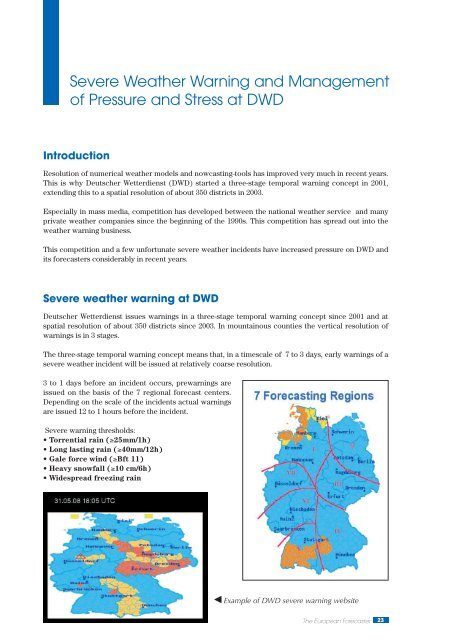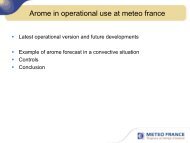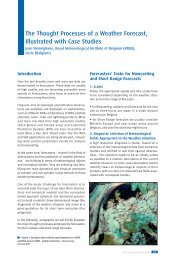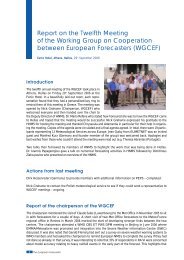Severe Weather Warning and Management of Pressure and Stress ...
Severe Weather Warning and Management of Pressure and Stress ...
Severe Weather Warning and Management of Pressure and Stress ...
You also want an ePaper? Increase the reach of your titles
YUMPU automatically turns print PDFs into web optimized ePapers that Google loves.
<strong>Severe</strong> <strong>Weather</strong> <strong>Warning</strong> <strong>and</strong> <strong>Management</strong><br />
<strong>of</strong> <strong>Pressure</strong> <strong>and</strong> <strong>Stress</strong> at DWD<br />
Introduction<br />
Resolution <strong>of</strong> numerical weather models <strong>and</strong> nowcasting-tools has improved very much in recent years.<br />
This is why Deutscher Wetterdienst (DWD) started a three-stage temporal warning concept in 2001,<br />
extending this to a spatial resolution <strong>of</strong> about 350 districts in 2003.<br />
Especially in mass media, competition has developed between the national weather service <strong>and</strong> many<br />
private weather companies since the beginning <strong>of</strong> the 1990s. This competition has spread out into the<br />
weather warning business.<br />
This competition <strong>and</strong> a few unfortunate severe weather incidents have increased pressure on DWD <strong>and</strong><br />
its forecasters considerably in recent years.<br />
<strong>Severe</strong> weather warning at DWD<br />
Deutscher Wetterdienst issues warnings in a three-stage temporal warning concept since 2001 <strong>and</strong> at<br />
spatial resolution <strong>of</strong> about 350 districts since 2003. In mountainous counties the vertical resolution <strong>of</strong><br />
warnings is in 3 stages.<br />
The three-stage temporal warning concept means that, in a timescale <strong>of</strong> 7 to 3 days, early warnings <strong>of</strong> a<br />
severe weather incident will be issued at relatively coarse resolution.<br />
3 to 1 days before an incident occurs, prewarnings are<br />
issued on the basis <strong>of</strong> the 7 regional forecast centers.<br />
Depending on the scale <strong>of</strong> the incidents actual warnings<br />
are issued 12 to 1 hours before the incident.<br />
<strong>Severe</strong> warning thresholds:<br />
• Torrential rain (≥25mm/1h)<br />
• Long lasting rain (≥40mm/12h)<br />
• Gale force wind (≥Bft 11)<br />
• Heavy snowfall (≥10 cm/6h)<br />
• Widespread freezing rain<br />
Example <strong>of</strong> DWD severe warning website<br />
The European Forecaster 23
<strong>Pressure</strong> on DWD <strong>and</strong> forecasters<br />
Especially in the media sector, competition has developed between the<br />
public weather service <strong>and</strong> many private weathercompanies since the<br />
beginning <strong>of</strong> the 1990s.<br />
Also private services have started to supply their customers <strong>and</strong> the public<br />
with weather warnings in the last few years. This has increased competition<br />
between the national weather service <strong>and</strong> private companies even more. This<br />
competition <strong>and</strong> a few unfortunate severe weather incidents have increased<br />
pressure on DWD <strong>and</strong> its forecasters considerably in the last years.<br />
While private weathercompanies had a strong appearance in the medias<br />
<strong>and</strong> made propag<strong>and</strong>a for their product they always said, in contrast to<br />
the state-owned weatherservice, they are not financed by taxpayers<br />
money. Hence DWD has been eagerly watched by the public in medias<br />
<strong>and</strong> internet chatrooms, by private companies <strong>and</strong> at last by the government<br />
more <strong>and</strong> more.<br />
Because the warning process is not fully automated, but still assisted by<br />
the forecaster, pressure on the national weather service is transferred to<br />
the forecasters.<br />
So forecasters are under particular pressure from the public, <strong>and</strong> from vigilant competitors always<br />
waiting for mistakes. Even colleagues who are less in the forefront <strong>of</strong> forecasting operations can have a<br />
pressure impact on forecasters.<br />
Immediate reports<br />
DWD is used to the challenge <strong>of</strong> severe weather warnings <strong>and</strong> false forecasts.<br />
How does DWD deal<br />
with this challenge?<br />
• Transparency<br />
- <strong>Weather</strong> reports are issued on the internet<br />
- <strong>Warning</strong>s are issued on the internet<br />
• Information management<br />
- Internal bulletins<br />
- external bulletins<br />
• Verification<br />
Therefore it has issued internal immediate reports since 2001, in<br />
which special weather situations are studied. The subjects <strong>of</strong> these<br />
immediate reports are the synoptic situation, quality <strong>of</strong> the numerical<br />
models <strong>and</strong> forecast tools, quality <strong>of</strong> early <strong>and</strong> actual warnings as well<br />
as the evaluation <strong>of</strong> the warning management <strong>of</strong> the central <strong>and</strong><br />
regional forecasting <strong>of</strong>fices.<br />
Since competition between the national weather service <strong>and</strong> the<br />
private weather industry has become stronger, the reports have, in<br />
the interests <strong>of</strong> transparency, been disseminated for all weather warnings<br />
on the internet.In addition, information management was<br />
increased by systematizising immediate reports.<br />
• Regional immediate report<br />
- if there was a severe weather warning in one <strong>of</strong> the responsible local areas.<br />
- if there was a severe weather incident in the regional area without being warned.<br />
• Time <strong>of</strong> issue: 07.00h next morning<br />
• National immediate report<br />
- if there was a severe weather warning in at least 7 local warning areas.<br />
- if there was a severe weather incident without being warned.<br />
• Time <strong>of</strong> issue: 07.00h next morning<br />
However this requires a lot <strong>of</strong><br />
time <strong>and</strong> effort by the workforce.<br />
Because <strong>of</strong> almost daily<br />
severe weather warnings more<br />
than 50 immediate reports were<br />
issued due to strong convective<br />
situations in summer 2008.<br />
24<br />
The European Forecaster
<strong>Management</strong> summary <strong>and</strong> verification report<br />
In case <strong>of</strong> a severe weather situation which covered most <strong>of</strong> Germany <strong>and</strong> caused considerable destruction,<br />
a comprehensive “<strong>Management</strong> Summary” is issued.<br />
It will be h<strong>and</strong>ed over to internal department <strong>of</strong> the weather service <strong>and</strong> the government.<br />
Verification reports, which are issued quarterly, are increasing transparency <strong>of</strong> the warning process <strong>and</strong><br />
lower the pressure on DWD <strong>and</strong> forecasters.<br />
Klaus Baehnke<br />
Deutscher Wetterdienst<br />
The European Forecaster 25







